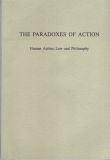用户登陆搜 索 |
查看图书
图书目录:FOREWORD by Malanuel A tienza
PREFACE CHAPTER I. PRELIMINARIES 1. The Concept of Action and the Traps of Language 2. The Relevance of the Concept of Human Action for Ethics and the Law 3. Human Freedom as a Prerequisite CHAPTER II: OUR INTUITIONS AND THE PARADOXES OF ACTION 1. Introduction 2. First Paradox: Are Actions Natural Phenomenoa or Products of Our Worldview? 3. Second Paradox: Are Actions Bodily Movements or Descriptions of Bodily Movements? 4. Third Paradox: Can We Be Mistaken About Our Own Actions'? 5. Fourth Paradox: Do We Perform Several Actions With One Single Bodily Movement? (The 'Accordion Effect' of Actions) 6. Fifth Paradox: What Are the Limits of Our Actions'? CHAPTER III: THE DEBATE IN THE PHILOSOPHY OF ACTION 1. The Controversy About the lndividuation of Actions 1. The minimizing position 24 / 2. The maximizing position 26 2. Individuation From the Agent's Point of View (G. H. von Wright) 3. Individuation as Imputation (H. L. A. Hart) 4. Some Conclusions CHAPTER IV: THE DEBATE IN CRIMINAL LAW 1. Introduction 2. The Definition of 'Action' in Criminal-Law Doctrine 1. The causal theo~' of action. The trilemma of causalism 40/2. The teleological theory of action. The partial abandoning of teleology 43 3. The social theory of action. Its insufficiency' 44 /4. A new version of the social theoo': the theoo' of action as meaning 46 3. The Treatment of Action in Anglo-Saxon Law 1. Act requirement and actus reus requirement. The orthodox theory of action 5(I / 2. Objectivism vs. subjectivism 52 4. Conclusions CHAPTER V: THE DEBATE IN THE PHILOSOPHY OF LANGUAGE 1. Introduction. Good Times for Pragmatics 2. Language Games (Wittgestein) 3. An Intentional Theory of Meaning (H. P. Grice) 1. The reconstruction of semantic concepts from pragmatic concepts 58 / 2. The role of conventions in the determination of meaning 60 "3. Searle's critique of the conception of Grice 61 4. How To Do Things With Words (J. L. Austin) 1. 'Constative utterances' and 'performative utterances" 62 ' 2. 'Locutionary acts', "illocutionary acts', and 'pertocutionar5, acts' 64 5. An Integrative Theory of Speech Acts (J. Searle) 1. Introduction 69 / 2. Rules and speech acts. The structure of illocutionary acts 70 / 3. 'A taxonomy of illocutionary acts' 72 / 4. Intention and illocutionary acts 76 6. Conclusions CHAPTER VI: THE PARADOXES DISSOLVED 1. Recapitulation. The Aspects of Action 1. Naturalistic, subjectivist, and social theories of action 79 / 2. The complementariness of the three groups of theories. Basic act, resuh-act and consequence-act. Act and action 80 / 3. The aspects of action and the distinction between locutionaD, illocutionary, and perlocutionar3' acts 81 / 4. Criteria tot the distinction between the three aspects of action 82 2. The Paradoxes of Action Reconsidered 1. Solution of the first paradox 80' 2. Solution of the second paradox 86 / 3. Solution of the third paradox 86 / 4. Solution of the fourth paradox 87 / 5. Solution of the fifth paradox CHAPTER VII: THE STRUCTURE OF ACTION 1. Introduction 2. The Sequence of Bodily Movements I. The role of bodily movements 91 / 2. Any bodily movement'? 92 / 3. Limits of bodily movements 93 3. Changes in the World 1. Do all actions bring about a change in the world? 93 / 2. "Action-internal' change 93, 3. Natural changes and institutional changes 94 4. From one world to the other 94 / 5. Any change? 94 4. The kink Between a Bodily Movement and a Change in the World 1. Causal relations 96 / 2. Conventional relations 97 / 3. Relations of implication? 97 5. Intention 1. Intentionality and Intention 98 / 2. Do intentions exist in the mind? Volitionists and anti- volitionists 99 / 3. Intentions and wants 101 / 4. Intention prior to action, and intention in acting 103 / 5. Internal (subjective) intention and external (objective) intention 104 / 6. Voluntariness and intention 106 6. The Interpretation or Meaning of an Action 1. What does "meaning of an action' mean? 107 / 2. The intentional interpretation of bodily movements 109 / 3. The non-intentional interpretation of bodily movements 112 CHAPTER VIII: OTHER KINDS OF ACTIONS l. Introduction 2. Institutional Actions 1. John Searle's distinction between natural and institutional actions 115,2. Two kinds of institutional actions 116 3. Remarks on Omission 1. Omission and bodily movements 118 / 2. Omission and changes in the world 1 I 9 ~ 3. Omission and links 119 4. Omission and intention 120 / 5. Omission and interpretation 120 EPILOGUE BIBLIOGRAPHY INDEX OF NAMES |

